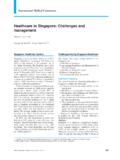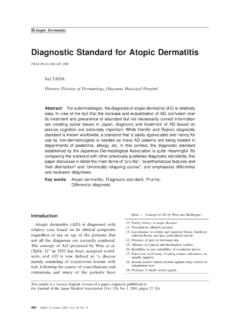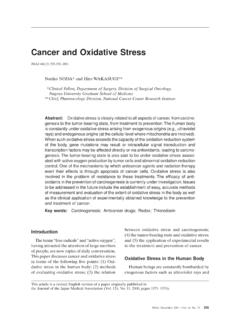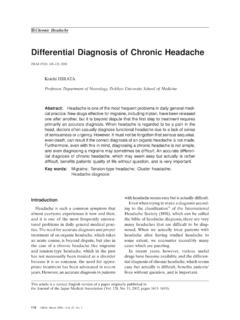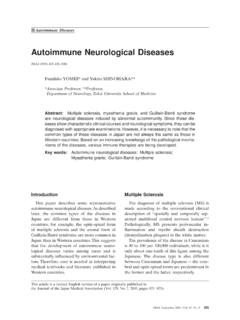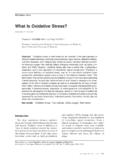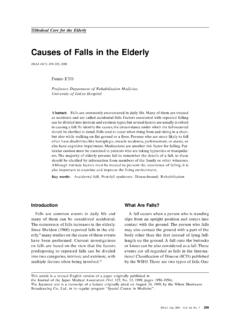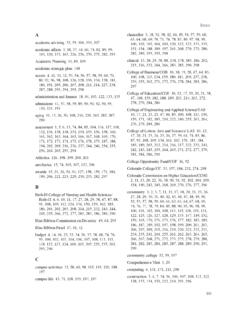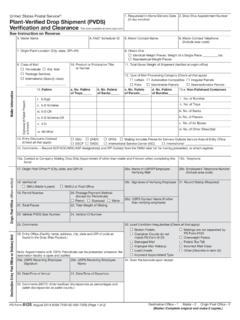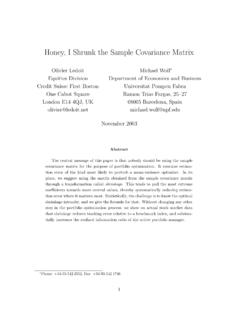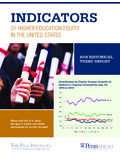Transcription of Morning Hypertension: A Pitfall of Current Hypertensive ...
1 234 Review ArticleMorning hypertension : A Pitfall of CurrentHypertensive ManagementJMAJ 48(5): 234 240, 2005 Kazuomi Kario*1 AbstractMorning hypertension has recently attracted more attention because of the close relation betweenblood pressure levels in the early Morning and cardiovascular risk. Cases of Morning hypertension , , higher blood pressure in the early Morning than in the evening, are classified into two types: the Morning -surge type, characterized by a marked increase in blood pressure in the early Morning , andthe nocturnal- hypertension type, characterized by high blood pressure that persists from nighttimeuntil early Morning . Although these two types are caused by different pathologic mechanisms, bothresult in Hypertensive organ damage and increase cardiovascular risk. Control of Morning hyper-tension can be regarded as the gateway to strict 24-hour blood pressure control. Standard antihyper-tensive treatment in accord with Current guidelines, when combined with chronobiologic antihyper-tensive treatment focused on Morning hypertension and guided by home blood pressure monitoring,seems to provide more effective prevention of cardiovascular wordsMorning hypertension , Morning surge, Nocturnal hypertension , Cardiovascular risk,Chronobiological antihypertensive medicationIntroductionMorning hypertension has attracted a greatdeal of attention in recent years.
2 Morningblood pressure (BP) levels measured athome are more closely associated with riskof damage to the brain, heart, and kidney, aswell as with the risk of all cardiovascularevents, than are BP levels measured at clin-ics. In addition, an increase in BP that occursfrom nighttime to early Morning ( , morn-ing-surge BP) is highly likely to be a cardio-vascular risk factor, independent of 24-hourBP levels. However, in Current clinical prac-tice, no adequate control of hypertension hasbeen achieved; Morning BP levels beforedosing are increased in more than half ofhypertensive patients on antihypertensivetherapy, even if they are under relativelygood BP control at clinics (Fig. 1).1 Thus, Morning hypertension is a challenge to thecurrent clinical practice of paper describes the diagnosis andtreatment of Morning hypertension in dailyclinical practice, providing the most up-to-date data obtained in studies from JichiMedical School.
3 *1 Division of Cardiovascular Medicine, Department of Medicine, Jichi Medical School, TochigiCorrespondence to: Kazuomi Kario MD, FAHA, FACC, FACP, Professor, Center of Excellence (COE) Program, Division of CardiovascularMedicine, Department of Medicine, Jichi Medical School, 3311-1, Yakushiji, Minamikawachi-cho Kawachi, Tochigi 329-0431, : 81-285-58-7344, Fax: 81-285-44-5317, E-mail: article is an updated and revised version of a paper published in the Journal of the Japan Medical Association, , , 2004,pages 554 , May 2005 Vol. 48, No. 5235 Definition of Morning HypertensionRecent clinical studies have shown that BPlevels in the early Morning are significantlyassociated with risk of damage to the brain,heart, and kidney as well as the risk of allcardiovascular events. The Ohasama Study, alongitudinal cohort study in which home BPwas measured once every Morning , showedthat Morning BP levels predicted cardiovas-cular death more accurately than randomlyobtained BP levels in a general population oflocal residents in use the definition of Morning hyper-tension based on BP measurements in theearly Morning and at bedtime (Fig.)
4 2).3 There is a consensus that, when home BP isused to exclude white-coat hypertension , anaverage of multiple home BP measurementsshould be used. Therefore, we exclude casesof whitecoat hypertension using a cut-offvalue of 135 mmHg for averaged BP valuesin the Morning and evening [morningness-eveningness (ME) average]. After that,patients are divided into sustained hyper-tension and Morning (predominant) hyper-tension according to a difference (ME differ-ence) in BP of 15 20 mmHg. That is, patientswith Morning (predominant) hypertensionare those with high average values formorning and evening BP and prominentvariations in Morning and evening BP. Incontrast, Hypertensive patients who showonly slight differences between Morning andevening BP values are considered to havesustained home BP(mmHg)135(mmHg)Poor morningBP controlGood morningBP control140 Total of 969 Hypertensive patients in treatment,mean age years, 42% males, 45 participating physicians in 33 facilitiesPoorBP controlGoodBP control38%18%21%23%r n 969 Clinic BPFig.
5 1 Jichi Morning hypertension research (J-MORE) study(From Kario K, et al. Circulation. 2003;108:e72 e73)Normotension(with elevation ofmorning BP) Morning (predominant) hypertension (mmHg )(mmHg)ME difference15 20 mmHgNormotensionSustainedhypertension135 mmHgME averageME average ( Morning BP Evening BP)/2ME difference Morning BP Evening BPFig. 2 Definition of Morning hypertension usingself-monitored home BP (Jichi Medical School)JMAJ, May 2005 Vol. 48, No. 5 Morning HYPERTENSION236 Figure 3 shows the risk of stroke inJapanese Hypertensive patients, based on ourdefinition of Morning (predominant) hyper-tension. In the Jichi Medical School Ambu-latory Blood Pressure Monitoring (JMSABPM) study (Wave 1) in elderly Japanesepatients with hypertension , we followed 519patients without a history of evident cardio-vascular events (mean age, 72 years) for amean of 41 months for possible onset of car-diovascular events.
6 The patients underwentbrain MRI and 24-hour ambulatory bloodpressure monitoring (ABPM) at this study, the ME average and ME differ-ence were independently associated withstroke Patients with white-coat hyper-tension who showed only slight variations inmorning and evening BP were used as con-trols, with cut-off values of ME average (sys-tolic pressure) and ME difference (systolicpressure) being 135 mmHg and 20 mmHg,respectively. As a result, stroke risk wasabout 2-fold for sustained hypertension for Morning (predominant) Among patients with white-coathypertension with a low ME average, therewas no increase in stroke risk for those withmorning BP have also performed an echocardio-graphic study of Hypertensive patients whoare under treatment to evaluate hyperten-sive heart disease and determine its relation-ship with the state of home BP control. Theresults showed that the left ventricular massindex was greater in patients with Morning (predominant) hypertension than in thosewith sustained hypertension , indicating ad-vanced left ventricular hypertrophy (Fig.)
7 4).From the above results, we consider thatour definitions of sustained hypertensionand Morning (predominant) hypertensionbased on home BP measurement are helpfulfor the management of hypertension in trulyhypertensive patients, excluding cases ofwhite-coat hypertension .(Total of 529 Hypertensive patients. Correction factors:age, sex, BMI, smoking, diabetes mellitus, hyperlipidemia, asymptomatic cerebral infarction, antihypertensive therapy)P (95% confidence interval)White-coathypertension(147 patients)White-coathypertension(with morningBP surge)(58 patients)Sustainedhypertension(228 patients) Morning (predominant)hypertensio n(86 patients) subgroupsAdjusted relative risk17 Fig. 3 Stroke risk of Japanese Hypertensive patients(JMS ABPM study, Wave 1)[Kario K, et al. Morning hypertension . (in preparation)]Fig. 4 Morning hypertension and left ventricularhypertrophy in Hypertensive patients onantihypertensive treatment(Kuroda T, Kario K, et al.
8 Presented at the 26th AnnualScientific Meeting of the Japanese Society of Hyper-tension on Oct. 31, 2003)0100200(g/m2)Left ventricular mass indexP average(mmHg) (with morningBP surge)SustainedhypertensionMorning(predo minant) (59patients)(20patients)(44patients)(27p atients)White-coathypertensionME difference(mmHg) , May 2005 Vol. 48, No. 5 Kario K237 Two Types of Morning HypertensionProminent Morning hypertension that ishighly reproducible with a home BP monitorcan be classified into two types accordingto BP levels at night determined by 24-hmonitoring (Fig. 5), namely, nocturnal hyper-tensive Morning hypertension and Morning -surge hypertension . The former type pre-sents a shift from nocturnal hypertensionand includes non-dippers, with a diminishednocturnal fall in BP, and risers, with noctur-nal levels higher than daytime levels. Thelatter group is characterized by BP elevationbeginning about 2 hours before getting outof bed, followed by further elevation afterrising from bed.
9 Both riser-type hyperten-sion and Morning -surge hypertension serveas independent risk factors for stroke. Con-ditions presumed to be associated with thesetwo types of Morning hypertension are listedin Table Morning hypertension of the nocturnalhypertensive typeThe cardiovascular risk of risers is highest,involving fatal stroke particularly cerebralhemorrhage and cardiac events includingsudden cardiac 9 Insufficient noctur-nal depression by short-acting antihyper-tensive drug therapy in Hypertensive patientsinduces Morning hypertension of this noctur-nal Hypertensive In addition, patientswith diabetes mellitus, poststroke state, car-diac failure, and sleep apnea syndrome fre-quently have this type of Morning hyper-tension. However, investigations of the timeof onset of cardiovascular events in diabeticpatients have found no diurnal variation inonset. In other words, the increased risk ofmorbidity due to Morning hypertensionoccurs in the nighttime, and the increasedrisk in the early Morning is an extension ofnighttime Surge-type Morning hypertensionAlthough it has been suggested that morningBP surge may be involved in the onset ofcardiovascular events, whether or not it is anactual risk for cardiovascular events has notbeen clarified.
10 Based on the results of theNocturnal- hypertension type(riser/nondipper)Surge typeSleepGetting out of bed135/85 Getting in bedMorninghyper-tension120/75 TimeBloodpressure(mmHg)Fig. 5 Abnormal diurnal variation in blood pres-sure in two types of Morning (predominant)hypertensionTable 1 Conditions associated with morninghypertensionNocturnal-hypertensio n (riser/nondipper) typeIncreased intravascular volume (heart failure, renalfailure, etc.)Abnormal autonomic nervous system (diabetes,parkinsonism, Shy-Drager syndrome, cardiac trans-plantation, orthostatic hypotension, etc.)Secondary hypertension (pheochromocytoma, primaryaldosteronism, Cushing s syndrome, etc.)Salt-sensitive hypertensionSleep disorders (sleep apnea syndrome, etc.)Metabolic syndrome (obesity)Depressive stateDementiaElderly patientsBlack male patientsHypertensive target organ damage [cerebral infarction,asymptomatic cerebrovascular disorder (silent cere-bral infarcts, deep white matter lesions), cardiachypertrophy, proteinuria, microalbuminuria, etc.]
